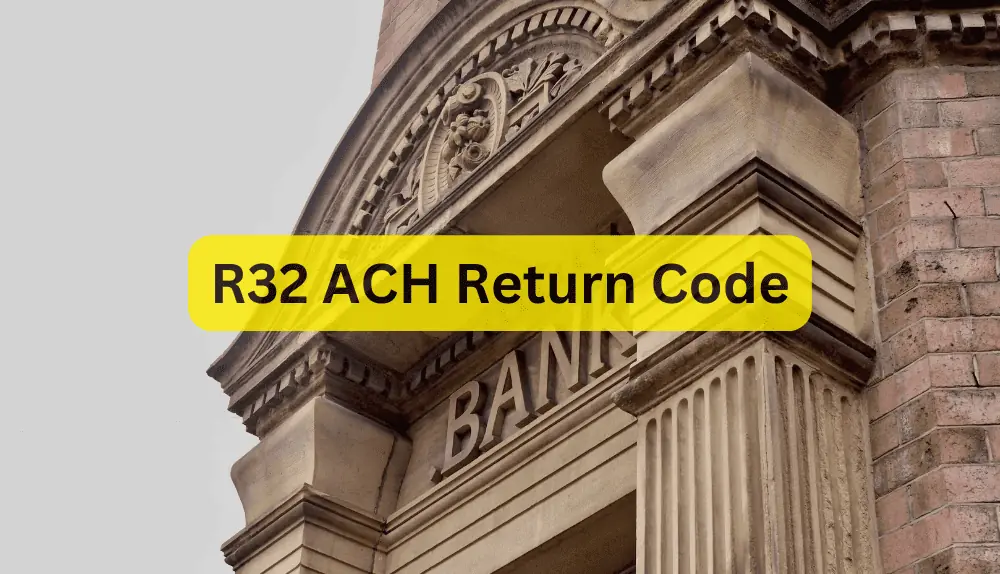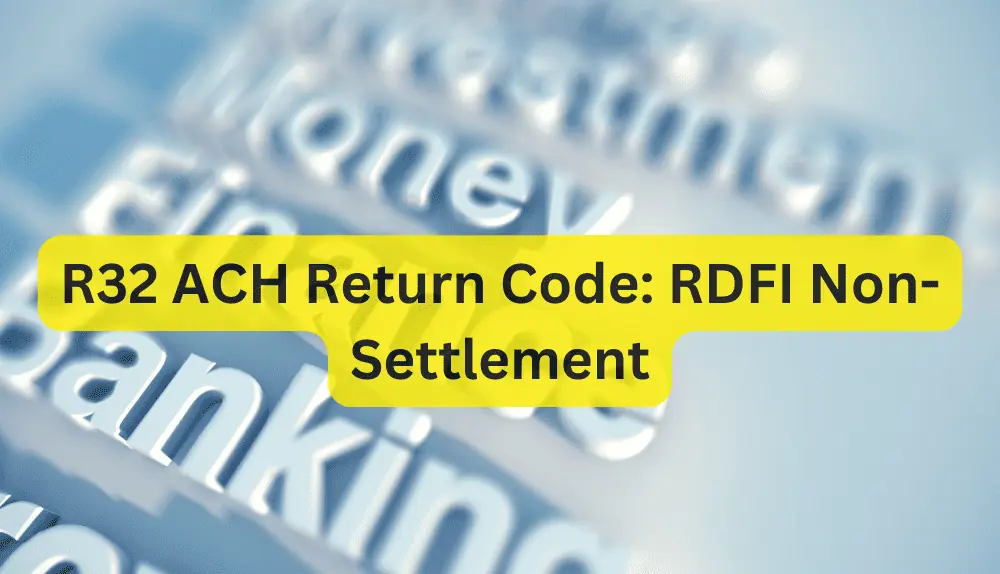R32 ACH Return Code RDFI Non-Settlement is an important code that plays a pivotal role in safeguarding the integrity of Automated Clearing House (ACH) transactions. This article will help you understand the R32 ACH return code and why it is important.
What Does R32 ACH Return Code Mean?
The ACH R32 Return Code refers to a specific code used in the Automated Clearing House (ACH) network to indicate that the Receiving Depository Financial Institution (RDFI) has not settled a particular entry. In simpler terms, it means that the RDFI has rejected or returned an ACH transaction, refusing to complete the transfer of funds for some valid reason.

When an ACH transaction is initiated, it goes through a series of stages involving the sending and receiving financial institutions. However, there are instances when the RDFI cannot complete the transaction. This could be due to various reasons, such as insufficient funds in the receiver’s account, an invalid account number, a closed account, or even issues with the transaction’s formatting.
The R32 Return Code acts as an important communication tool between financial institutions, signaling that the transaction could not be settled. Subsequently, the originating financial institution (ODFI) receives notification of the rejection, allowing them to take appropriate actions like notifying the sender and investigating the cause of the rejection.
In summary, the ACH R32 Return Code is a crucial component of the ACH network, facilitating the proper functioning of electronic fund transfers and helping to maintain the accuracy and security of financial transactions.
Reasons R32 ACH Return Code Can Occur
The ACH R32 Return Code is a significant indicator that denotes a failure in settling an Automated Clearing House (ACH) transaction. Various reasons can lead to the occurrence of this code, each representing specific issues that impede the successful completion of the electronic fund transfer. Below are some common reasons why the ACH R32 Return Code may occur:
Insufficient Funds
One of the most prevalent reasons for the R32 Return Code is the lack of sufficient funds in the receiver’s account. When the RDFI attempts to process the transaction, it finds that the available balance is not enough to cover the transfer, leading to the rejection.
Invalid Account Number
If the account number provided in the ACH transaction is incorrect or does not match the receiver’s account information, the RDFI will be unable to process the payment, resulting in the R32 Return Code.
Closed Account
In scenarios where the receiver’s account has been closed or is no longer active, the RDFI will not be able to settle the ACH transaction, leading to its rejection.
Transaction Amount Limitations
Some bank accounts have restrictions on the maximum amount that can be transferred in a single transaction. If the ACH payment exceeds this limit, the RDFI will return the transaction using the R32 code.
Frozen Accounts
Accounts that have been frozen or restricted due to legal or compliance issues cannot be used for processing ACH transactions, resulting in the R32 Return Code.
Transaction Formatting Errors
The ACH network has strict formatting requirements for transactions. If the transaction details are not properly structured or contain errors, the RDFI may reject the payment.
Account Restrictions
Certain bank accounts may have specific restrictions or limitations on the types of transactions they can accept, leading to the ACH transaction being declined.
Unauthorized Transactions
If the ACH transaction is considered unauthorized or fraudulent, the RDFI will reject it to protect the account holder’s interests.
Steps to Fix R32 ACH Return Code
Fixing the ACH R32 Return Code requires careful investigation and appropriate action to address the specific reason for the rejection. Here are the steps you can take to rectify the issue:

Review Transaction Details
Start by reviewing the transaction details, including the receiver’s account number, the transaction amount, and any other pertinent information. Ensure that all the provided information is accurate and matches the receiver’s account details.
Check Receiver’s Account Balance
Verify that the receiver’s account has sufficient funds to cover the ACH transaction. If there are insufficient funds, you may need to inform the receiver to deposit enough money to complete the transaction successfully.
Contact the Receiver
If the ACH R32 Return Code occurred due to an invalid or closed account, get in touch with the receiver to confirm their account details and update them if necessary. If the account is closed, the receiver will need to provide an active account to process the payment.
Verify Transaction Limits
Ensure the ACH transaction amount does not exceed any limits set on the receiver’s account. If the amount exceeds the limit, consider breaking the transaction into smaller, allowable amounts or seek an alternative payment method.
Correct Formatting Errors
If the R32 Return Code resulted from transaction formatting errors, review the ACH file structure and ensure it complies with the ACH network’s requirements. Rectify any formatting issues and resubmit the corrected transaction.
Check for Account Restrictions
Some accounts may have specific restrictions on the types of ACH transactions they can accept. Verify with the receiver’s financial institution if any limitations on the account caused the rejection.
Address Fraud Concerns
If the ACH transaction is flagged as unauthorized or fraudulent, promptly investigate the issue. Verify the authenticity of the transaction with the receiver and take necessary actions to prevent potential fraud.
Resubmit the Transaction
After identifying and rectifying the reason for the ACH R32 Return Code, resubmit the corrected transaction through the ACH network. Ensure that all the necessary modifications have been made to prevent a recurrence of the rejection.
Communication with All Parties
Throughout the process, maintain open communication with both the sender and the receiver, keeping them informed about the status and resolution of the ACH transaction.
By following these steps and addressing the specific cause of the ACH R32 Return Code, you can increase the likelihood of a successful ACH transaction and facilitate smooth electronic fund transfers within the ACH network.
How Can Businesses Deal With ACH R32 Return Code
Dealing with the ACH R32 Return Code can be a challenging but essential task for businesses. Addressing the issue promptly and effectively is crucial to maintaining smooth financial operations and ensuring customer satisfaction. Here are some steps businesses can take to handle the ACH R32 Return Code:
Notification and Verification
Upon receiving the ACH R32 Return Code notification from the originating financial institution (ODFI), businesses should promptly inform the sender about the transaction rejection. Verify the accuracy of the transaction details and cross-check them with the receiver’s account information to identify any potential errors.
Customer Communication
If the R32 Return Code occurred due to an issue with the receiver’s account, communicate with the customer to rectify the problem. Promptly inform them of the transaction rejection and request updated account information if necessary. Keeping customers informed and involved helps build trust and loyalty.
Payment Alternatives
In case the ACH transaction cannot be completed due to insufficient funds or other issues with the receiver’s account, offer alternative payment options to the customer. This could include credit card payments, wire transfers, or checks, depending on the business’s capabilities and the customer’s preferences.
Transaction Resubmission
After addressing the cause of the ACH R32 Return Code, resubmit the corrected transaction through the ACH network. Ensure that all necessary modifications have been made to prevent another rejection.
Transaction Monitoring
Implement a system to monitor ACH transactions regularly. Keeping a close eye on transaction activity can help detect potential issues early on and allow for quick resolution.
Update Account Information
Encourage customers to keep their account information up to date and provide clear instructions on how to make changes when needed. This can help reduce the likelihood of transaction rejections due to outdated account details.
Compliance and Security Measures
Ensure that the business is compliant with ACH network rules and regulations. Implement security measures to protect against unauthorized transactions and potential fraud.
Partner with Reliable Banks
Collaborate with reputable financial institutions that offer reliable ACH processing services. Establishing a strong partnership can minimize the occurrence of ACH return codes and streamline transaction processes.
Customer Support
Provide efficient and responsive customer support to handle any inquiries or concerns related to ACH transactions. Having knowledgeable staff who can assist customers with ACH-related issues can significantly enhance customer satisfaction.
Dealing with the ACH R32 Return Code requires diligence, clear communication, and a proactive approach to resolving the underlying issues. By implementing these strategies, businesses can minimize ACH transaction rejections, streamline their financial processes, and maintain positive relationships with both customers and financial partners.
Final Words
In conclusion, the ACH R32 Return Code serves as a critical signal within the intricate world of electronic fund transfers, providing valuable insights into the challenges and potential hurdles faced by businesses and financial institutions alike. By understanding the reasons behind its occurrence and taking proactive steps to rectify the underlying issues, businesses can navigate the ACH landscape with confidence and efficiency.
Timely communication with customers, diligent monitoring of transactions, and adherence to compliance and security measures are all vital elements in successfully dealing with the ACH R32 Return Code.
Embracing these practices not only fosters smoother financial operations but also fosters trust and reliability in the eyes of customers and partners. As the financial landscape continues to evolve, the ability to navigate ACH transactions successfully becomes an indispensable asset, ensuring that businesses can continue to thrive in the fast-paced world of electronic transactions.
Frequently Asked Questions (FAQs)
How can I avoid ACH R32 Return Code rejections?
To prevent ACH R32 Return Code rejections, ensure that all transaction details, including the receiver's account information and transaction amount, are accurate. Also, monitor account balances, stay updated with account information changes, and comply with ACH network rules.
What should I do if an ACH transaction receives an R32 Return Code?
If your ACH transaction receives an R32 Return Code, promptly communicate with the sender or receiver to verify the transaction details. Identify the reason for the rejection and take appropriate actions to resolve the issue before resubmitting the corrected transaction.
Are there limits on the transaction amount for ACH transfers?
Yes, some bank accounts have transaction amount limits. If the ACH transaction amount exceeds this limit, the transaction may be rejected with the ACH R32 Return Code. Check with the receiver's bank to ensure the amount is within the permissible limit.
Can an ACH R32 Return Code be reversed?
No, the ACH R32 Return Code is used to indicate a rejected transaction, and it cannot be reversed. The sender will need to correct the issue and resubmit the transaction for processing.
Can an ACH R32 Return Code be disputed?
The ACH R32 Return Code itself cannot be disputed since it indicates a rejected transaction. However, if there is a genuine error or misunderstanding, the underlying issue can be addressed and resolved between the parties involved.
Is the ACH R32 Return Code the only code for transaction rejections?
No, there are various return codes in the ACH network, each representing different reasons for transaction rejections. The specific code used depends on the nature of the rejection and the circumstances surrounding the failed transaction.

